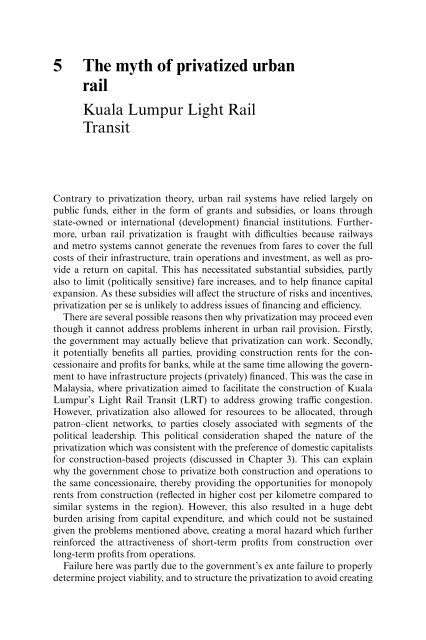PRIVATIZATION Privatization in Malaysia, Regulation, rent-seeking and policy failure
PRIVATIZATION Privatization in Malaysia, Regulation, rent-seeking and policy failure
PRIVATIZATION Privatization in Malaysia, Regulation, rent-seeking and policy failure
You also want an ePaper? Increase the reach of your titles
YUMPU automatically turns print PDFs into web optimized ePapers that Google loves.
5 The myth of privatized urbanrailKuala Lumpur Light RailTransitContrary to privatization theory, urban rail systems have relied largely onpublic funds, either <strong>in</strong> the form of grants <strong>and</strong> subsidies, or loans throughstate-owned or <strong>in</strong>ternational (development) f<strong>in</strong>ancial <strong>in</strong>stitutions. Furthermore,urban rail privatization is fraught with difficulties because railways<strong>and</strong> metro systems cannot generate the revenues from fares to cover the fullcosts of their <strong>in</strong>frastructure, tra<strong>in</strong> operations <strong>and</strong> <strong>in</strong>vestment, as well as providea return on capital. This has necessitated substantial subsidies, partlyalso to limit (politically sensitive) fare <strong>in</strong>creases, <strong>and</strong> to help f<strong>in</strong>ance capitalexpansion. As these subsidies will affect the structure of risks <strong>and</strong> <strong>in</strong>centives,privatization per se is unlikely to address issues of f<strong>in</strong>anc<strong>in</strong>g <strong>and</strong> efficiency.There are several possible reasons then why privatization may proceed eventhough it cannot address problems <strong>in</strong>he<strong>rent</strong> <strong>in</strong> urban rail provision. Firstly,the government may actually believe that privatization can work. Secondly,it potentially benefits all parties, provid<strong>in</strong>g construction <strong>rent</strong>s for the concessionaire<strong>and</strong> profits for banks, while at the same time allow<strong>in</strong>g the governmentto have <strong>in</strong>frastructure projects (privately) f<strong>in</strong>anced. This was the case <strong>in</strong><strong>Malaysia</strong>, where privatization aimed to facilitate the construction of KualaLumpur’s Light Rail Transit (LRT) to address grow<strong>in</strong>g traffic congestion.However, privatization also allowed for resources to be allocated, throughpatron–client networks, to parties closely associated with segments of thepolitical leadership. This political consideration shaped the nature of theprivatization which was consistent with the preference of domestic capitalistsfor construction-based projects (discussed <strong>in</strong> Chapter 3). This can expla<strong>in</strong>why the government chose to privatize both construction <strong>and</strong> operations tothe same concessionaire, thereby provid<strong>in</strong>g the opportunities for monopoly<strong>rent</strong>s from construction (reflected <strong>in</strong> higher cost per kilometre compared tosimilar systems <strong>in</strong> the region). However, this also resulted <strong>in</strong> a huge debtburden aris<strong>in</strong>g from capital expenditure, <strong>and</strong> which could not be susta<strong>in</strong>edgiven the problems mentioned above, creat<strong>in</strong>g a moral hazard which furtherre<strong>in</strong>forced the attractiveness of short-term profits from construction overlong-term profits from operations.Failure here was partly due to the government’s ex ante <strong>failure</strong> to properlydeterm<strong>in</strong>e project viability, <strong>and</strong> to structure the privatization to avoid creat<strong>in</strong>g


